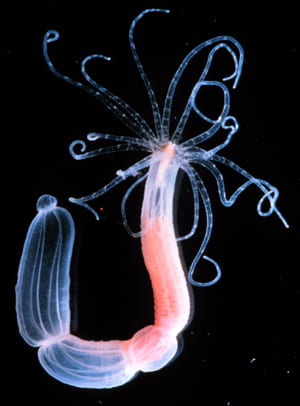
Hello! My name is Phillip Zhou, and I’m a rising sophomore at Amherst College majoring in biology and mathematics. I love learning about developmental biology, applied mathematics, and evolution. Two weeks ago, I started work with the Gibson Lab at the Stowers Institute for Medical Research, where I will be using the starlet sea anemone Nematostella vectensis, to answer questions about evolution, development, and regeneration of the apical organ in Nematostella.
Developmental biology broadly studies how living things grow, organize their bodies, and regenerate from injury. Within that field, several questions naturally arise, such as how animals develop distinct front and back ends and put their nervous systems together. It turns out that a sensory organ called the apical organ possessed by Nematostella potentially has much to do with the evolution of heads as we know them today!
The apical organ is a transient structure in the mobile larva of Nematostella which likely allows it to gather information on its environment, including tactile and visual information. What is so curious about this structure is that it is associated with a set of genes that are evolutionarily conserved, or that are present in many distantly related organisms such as worms, sea urchins, and even flies. Moreover, these genes are associated with the head region of bilaterally symmetrical animals, which are animals that have one plane of symmetry down the middle of their bodies. This is surprising because these anemones are incredibly different from bilaterally symmetrical animals from an evolutionary and anatomical perspective. Additionally, it is surprising that there is some sort of “head-like” organization in the sea anemone given that its adult nervous system is structured like a diffuse net of nerves, much unlike the structured nervous system that, say, humans have. Thus, studying this animal can potentially shed light on how our ancestors might have looked, and what sets of genes might have played a role in building their head regions as well. I would like to study genes that are associated with the apical organ that have not been previously characterized to ultimately establish genetic connections with other animals and ideas about what genes the earliest animal nervous systems might have used. In particular, I will leverage established protocols for in situ hybridization and genetic loss of function experiments using short hairpin RNAs. These techniques allow us to observe the expression patterns of certain genes in Nematostella and interrogate the function of genes by seeing what happens when they do not work properly.
At Amherst, I am doing research on Nematostella with Professor Ragkousi, who focuses on aspects of biology including the formation of epithelial layers, or sheets of cells, and what genes are essential to this sort of organization. I am personally interested in learning more about the cilia of Nematostella and their role in development. Ultimately, I feel this research experience will help me with my continued research at Amherst as the apical organ has a ciliary component, so much of the techniques for visualizing cilia will come in handy later on. In addition, this research is focused on the nervous system of Nematostella, which is not a topic I am very familiar with, so I hope to learn much about genes associated with the formation of new neurons and neuroscience as a whole. I am also interested in learning about systems biology, which is a highly interdisciplinary field of biology that attempts to answer the question of “what is life?” and study emergent properties of biological systems. Living things are a whole that is greater than the sum of their parts, or in other words, certain novel properties of living things “emerge” by virtue of being organized in a particular way despite being made of chemical compounds, including growth and regeneration, properties that are within the field of developmental biology. This field combines mathematical and biological ways of thinking, and I believe learning about the development of Nematostella will contribute to my ability to learn more about biological systems as a whole.
Outside of research, I like brushing up on my drawing skills, playing the bass, looking at small animals I find out and about, and reading the occasional manga. This summer, I’m housed near Stowers Institute in Kansas City. I hope to give students who might be interested in developmental biology or Stowers Institute a chance to get to know the research that is done there!
You must be logged in to post a comment.